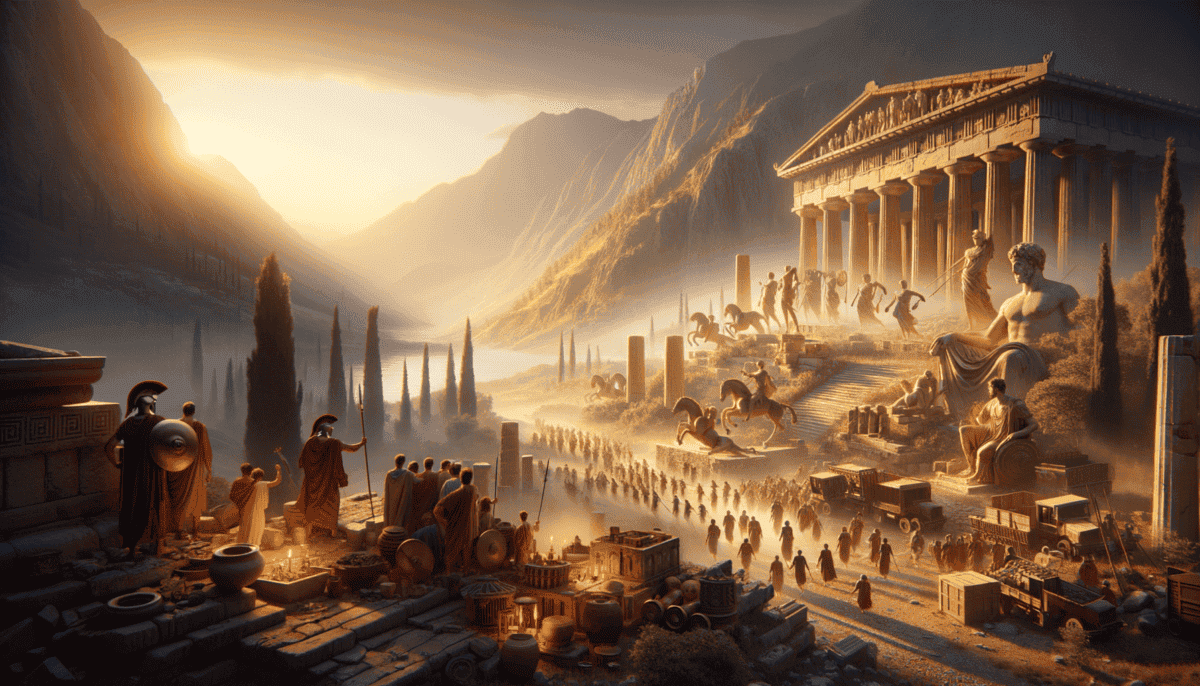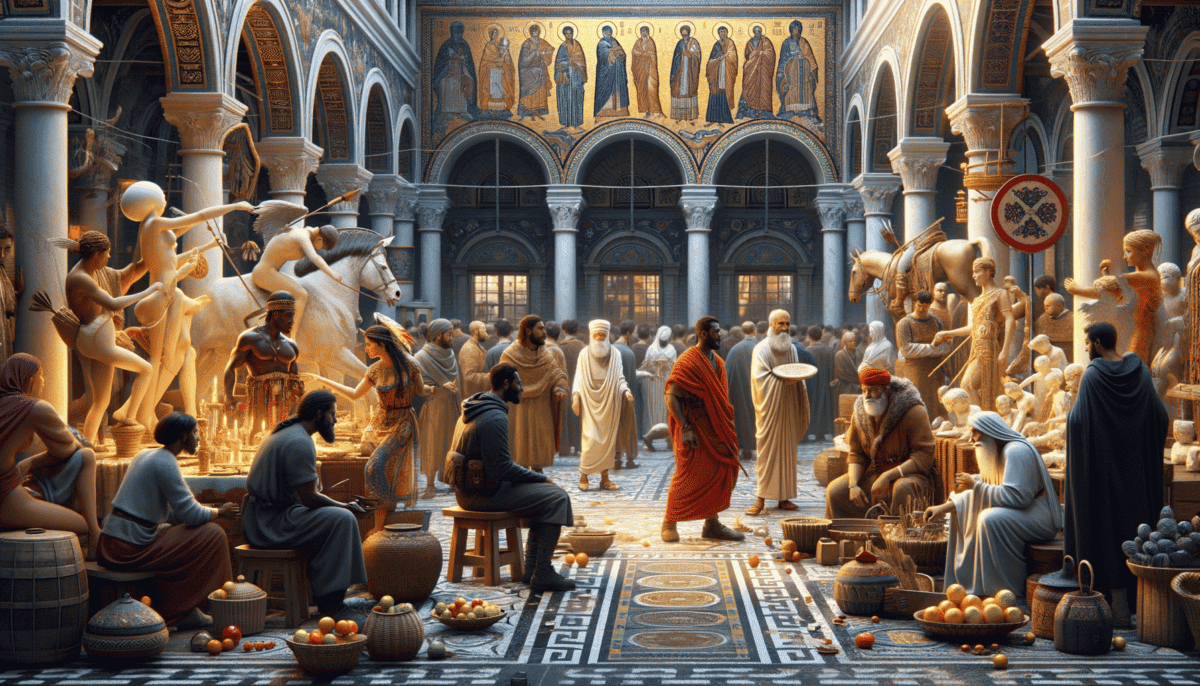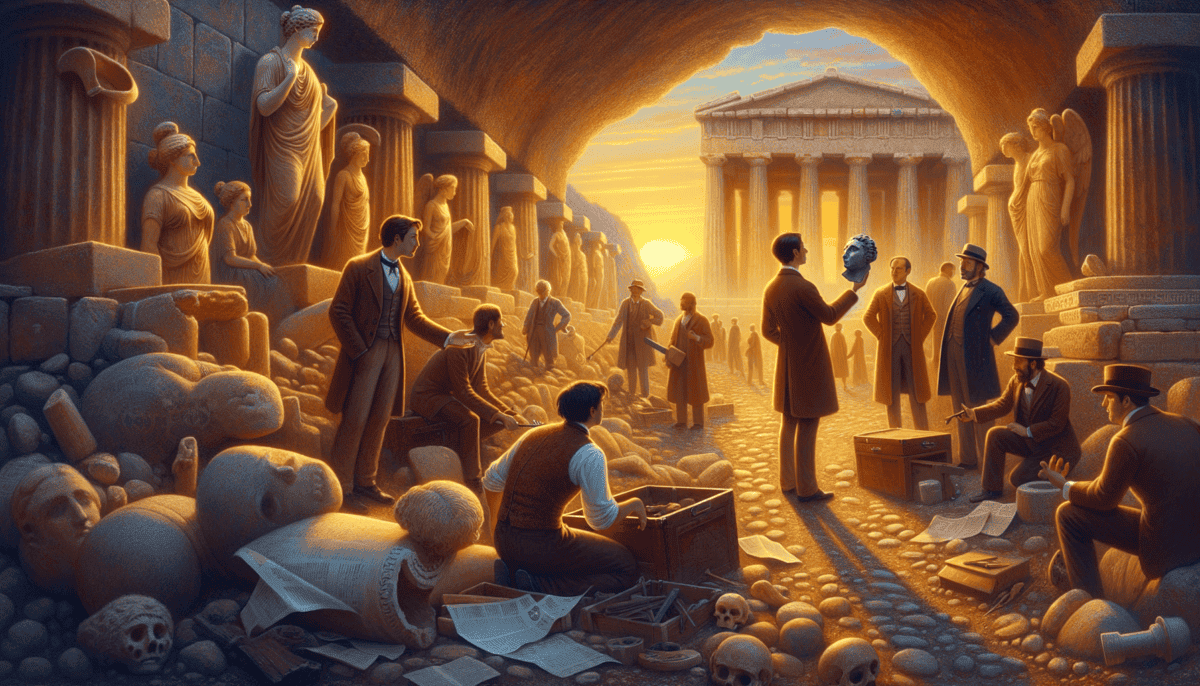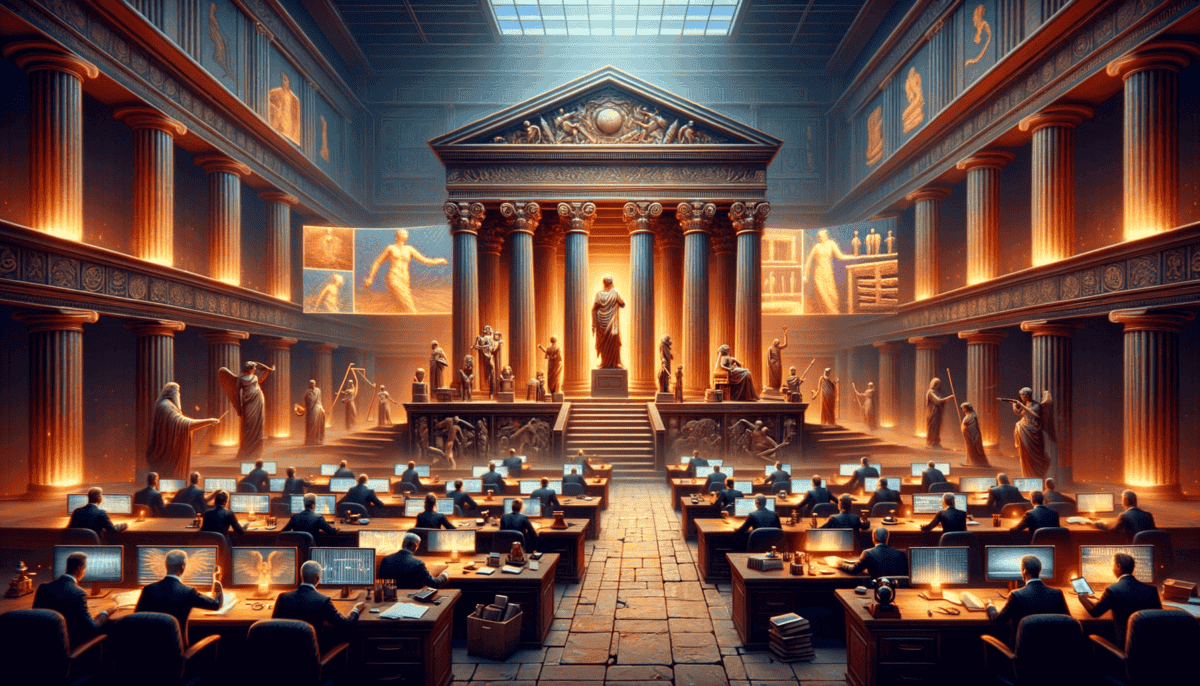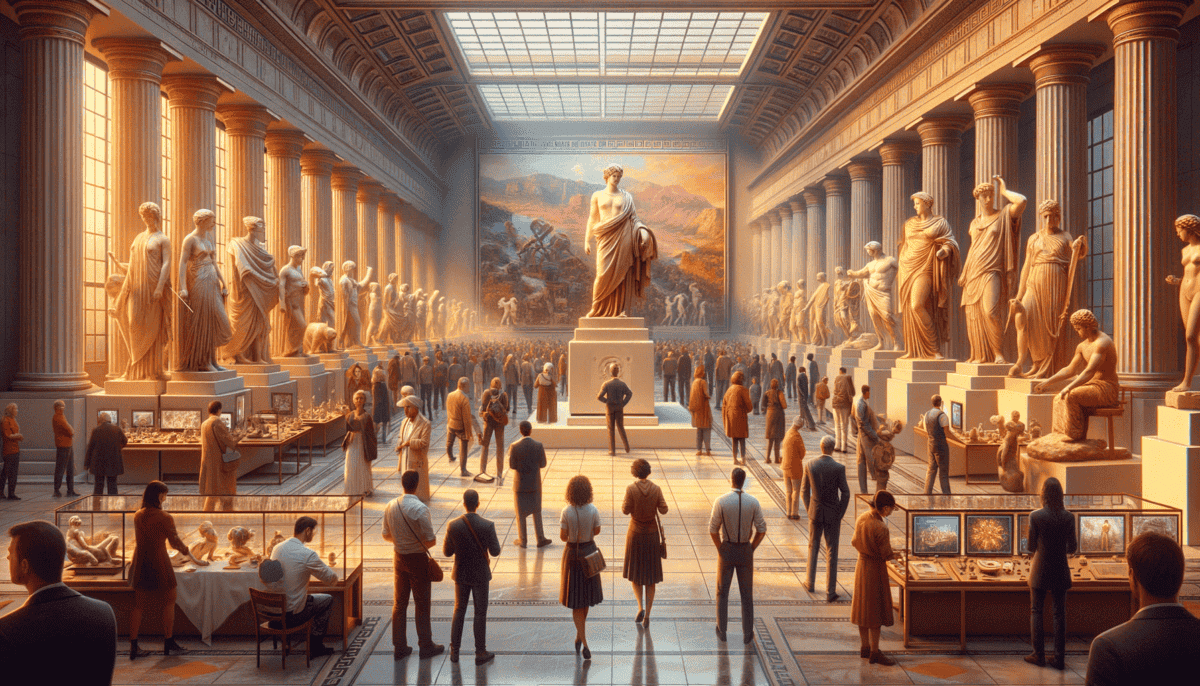A Time of Masters and Marble
Long ago, in a sunny land called Greece, amazing artists made beautiful things. The most famous artist was Phidias. He loved to make giant statues that touched the sky!
"Come see what I made!" Phidias would call to the people of Athens. They would gather around his workshop, their eyes wide with wonder.
Another great artist was Myron. He was really good at making statues look like they were moving. His most famous work was called "The Discus Thrower." It showed an athlete frozen in time, about to throw a disc.
"How do you make them look so real?" young artists would ask Myron.
"Watch people carefully," he would say with a smile. "See how they move. Then make your statue tell their story."
Making Art in Ancient Greece
The artists worked with big pieces of marble. First, they would draw their idea. Then, they used special tools to chip away at the stone. It was like magic – they could see the statue hiding inside the marble!
They used these tools:
• Chisels for carving
• Hammers for shaping
• Fine tools for details
• Polish for shine
Colors of the Past
Here's something surprising – the statues weren't white like we see them today! The artists painted them with bright colors. Red for cloaks, blue for eyes, and gold for hair. They looked like real people!
"Why do you paint them?" a child once asked Phidias.
"Because life is full of color," he answered. "Our art should show that beauty."
Keeping Art Safe
The Greek people loved their art very much. They put statues in special buildings called temples. These temples were like giant treasure boxes that kept the art safe.
But dark clouds were gathering. Other people from far away lands started to hear about the beautiful Greek art. They wanted these treasures for themselves.
Young artists like Marcus worried about this. "Master Phidias, what if someone tries to take our art away?"
Phidias patted the marble he was working on. "Our art tells our stories," he said. "As long as people remember these stories, our art will live forever."
Little did they know how important those words would become. The greatest test for Greek art was just beginning…
When Rome Came Marching
The sun was setting over Athens when the first Roman soldiers appeared. Their armor sparkled like fish scales in the orange light. The Greeks watched from their city walls, worried about their beautiful art.
“Look at these amazing statues!” said Marcus Claudius, a Roman general. He stood in front of a big marble statue of Athena. “We must have these for Rome!”
The Great Taking
The Romans began to pack up Greek statues very carefully. They used special wooden boxes and lots of soft blankets. They treated the art like treasure, but they still took it away from its home.
“Where are they taking our gods?” a little Greek girl asked her mother.
“To Rome, dear one. To Rome.”
New Homes for Old Art
In Rome, people were very excited about the Greek art. They put the statues in their houses and gardens. Rich Romans even learned to speak Greek because they thought it was fancy!
Some Romans tried to copy Greek art:
• They made new statues that looked like Greek ones
• They learned Greek ways of painting
• They built buildings that looked like Greek temples
• They wrote their names in Greek style
Two Worlds Meet
“Why do you want our art so much?” a Greek artist asked a Roman collector.
“Because it’s the most beautiful art in the world,” the Roman answered. “We want to learn from it.”
Changes and Chances
But not all the art made it safely to Rome. Some ships sank in storms. Some statues broke during the long journey. And some art was hidden by Greeks who didn’t want to lose it.
A young Greek boy named Theo watched as another cart of statues rolled away. “Will we ever see our art again?” he asked his grandfather.
The old man smiled sadly. “Our art may travel far, but its heart will always be Greek. And someday, people will understand that these treasures belong to everyone who loves beauty.”
As the sun set on another day, both Greeks and Romans looked at the same stars. The art they fought over would soon face even bigger adventures. New empires would rise, and with them would come new challenges for the ancient treasures of Greece…
️ When Empires Changed Everything
The world was changing fast. After the Romans, new people came to Greece. They saw things differently than the Greeks and Romans did.
New Ways of Making Art
Maria, a young artist, watched as her father worked on a special picture called a mosaic. He used tiny colored stones to make beautiful images.
“Why don’t we make statues like the old Greeks did?” Maria asked.
“Times have changed, little one. Now we make art to honor God, not the old gods.”
The Ottoman Changes
Years passed, and another group called the Ottomans came to Greece. They brought new ideas about art too.
“What beautiful buildings!” said Ayşe, an Ottoman girl, looking at the old Greek temples.
“Yes, but we will build our own beautiful things,” her father said. “And we will keep some of the old things too.”
Some ways art changed during this time:
• Churches became mosques
• New patterns replaced old Greek designs
• Different colors became popular
• New stories were told in art
Hidden Treasures
Some Greeks didn’t want their old art to change. They hid statues and paintings in secret places.
“Grandmother, why did you hide this old vase?” asked Nikolas, finding a dusty treasure in the cellar.
“To keep our stories alive,” she whispered. “Each piece of art tells a story about who we are.”
People From Far Away
Soon, visitors from other countries started coming to Greece. They were very interested in the old art.
“Look at all these amazing old things!” said Thomas, an English traveler. “We should study them and show them to people in our countries.”
More and more people came to look for Greek art:
• Scientists who studied old things
• Rich people who collected art
• Artists who wanted to learn
• Writers who told stories about Greece
As the sun set over the ancient hills of Greece, little Maria held her grandmother’s hand. “Will our art ever come back home?” she asked.
“The story isn’t over yet,” her grandmother said with a smile. “Sometimes the longest journeys lead back to where they started.”
️ Digging Up the Past
The year was 1801. The sun was hot over Athens. A man named Lord Elgin wiped sweat from his forehead as he looked up at the Parthenon.
The Great Hunt Begins
“These marble sculptures are amazing!” said Lord Elgin. “They should be in a museum where everyone can see them.”
But young Dimitri, watching from behind a column, didn’t agree. “Those belong to our city,” he whispered to his friend Sofia.
All over Greece, teams of people were digging:
• In old temples
• Under the ground
• Inside caves
• Near ancient cities
New Tools, Old Treasures
“Look what I found!” shouted a worker named Andreas. He held up a beautiful old vase.
“Careful!” said Dr. Thompson, the archaeologist. “It’s over 2,000 years old!”
The Big Problem
Soon, ships filled with Greek art sailed away to other countries. Many Greeks felt sad and angry.
“They’re taking our history away,” said Sofia’s grandmother, watching another ship leave the harbor.
“But they’re keeping the art safe in big museums,” argued a British collector.
Learning New Things
Scientists learned a lot from studying the old art:
“Each piece tells us a story,” explained Dr. Thompson to Dimitri. “Like this tiny coin shows what their kings looked like!”
Keeping Art Safe
People learned better ways to protect old art:
“We must be very gentle,” said Maria, now grown up and working as a helper. “These pieces are like precious memories.”
They used special boxes, careful cleaning, and safe places to keep everything.
As night fell over the dig site, Dimitri looked at the empty spaces where statues once stood. “Will we ever see them again?” he wondered.
Sofia put her hand on his shoulder. “The world is changing,” she said. “People are starting to think differently about who should keep these treasures.”
Fighting for Our Art
The bright lights of the United Nations building lit up the New York sky. Maria stepped up to speak. She was fighting to bring Greek art back home.
A New Kind of Battle
“These marble statues belong in Greece,” Maria said firmly. She showed pictures of empty spaces in Greek museums.
Little Alex watched the news at home in Athens. “Mom, why are our statues in other countries?” he asked.
“It’s a long story,” his mom said. “But we’re trying to bring them back.”
Special Art Detectives
Detective Sofia smiled at her computer screen. “Got you!” she said. She had found another lost Greek vase.
Museums Working Together
Museums around the world started talking to each other:
“Look!” Alex pointed at the TV. “That statue is coming back to Athens!”
People cheered as the marble statue was carefully lifted from its crate.
New Ways to Keep Art Safe
Scientists made cool new tools to protect art:
• Special alarm systems
• Secret marks to prove where art came from
• Digital copies of everything
• Super-strong glass cases
The World Helps Greece
“We all love Greek art,” said Dr. Lee from China. “It belongs to everyone, but Greece should keep the real pieces.”
At the Greek museum, Alex pressed his nose against the glass. “This statue just came home,” he read on the sign.
“And more will come,” his mom smiled. “People understand now. Art belongs where it was made.”
That night, Maria looked at the Acropolis lit up against the dark sky. Tomorrow would bring another chance to bring more treasures home.
The Art Lives Forever
The morning sun sparkled on the marble of the Parthenon. Alex stood with his classmates, looking up at the ancient temple.
A Special Day
“Today is magic!” Alex jumped up and down. A famous statue was coming home after being away for hundreds of years.
Maria, now the museum director, smiled at the excited children. “This is your history coming home.”
Art That Never Dies
Kids from all over the world now visit Greece to see the art:
• They learn ancient stories
• They draw the statues
• They make their own art
• They share pictures online
Keeping Art Safe Forever
“We use robots to clean the statues now,” Sofia explained to the students. “And special lights keep them from getting old.”
The World’s Art Family
“Art brings people together,” Maria told reporters. “Now museums everywhere work as friends.”
The children watched as the returning statue was carefully placed in its new home. It seemed to smile in the sunlight.
Looking to Tomorrow
Alex touched the smooth marble base of a statue. “Will we find all the lost art someday?” he asked.
“Maybe not all,” Maria said. “But we’ll keep trying. And we’ll make new art too. That’s what the ancient Greeks would want.”
That evening, as the sun set behind the Acropolis, Alex drew a picture of his favorite statue. Next to him, a little girl from Japan drew the same statue. They smiled at each other.
The art of ancient Greece had done what great art always does – it brought people together, told amazing stories, and made the world more beautiful.


